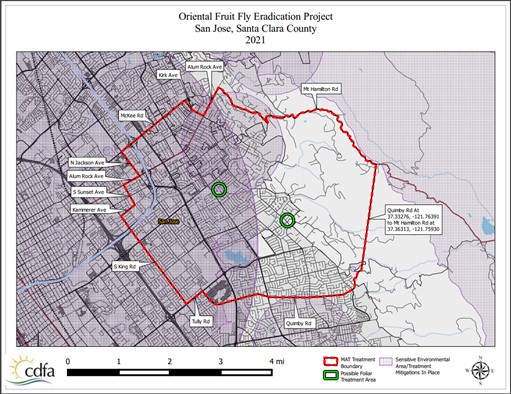Oriental Fruit Fly Detected in the City of San José
Public Reminded to Not Bring Fruits and Vegetables from Outside California
SANTA CLARA COUNTY, CA – The California Department of Food and Agriculture and the United States Department of Agriculture are beginning an extensive survey and eradication project in response to the detection of two Oriental Fruit Flies on June 22 and 23 a mile and a half apart in the City of San José. Treatments for these flies will take place on June 29, 2021. The State will use the same safe method that successfully treated a similar Oriental Fruit Fly infestation in Saratoga (in 2019) and in Morgan Hill (in 2020). The treatment has no community impact.
The Oriental Fruit Fly (OFF) is known to infest more than 230 different fruits and vegetables. Important California crops at risk from infestation include apples, pears, stone fruits, citrus, dates, avocados, tomatoes, peppers, and many vegetables. Damage occurs when the female lays eggs inside the fruit. The eggs hatch into maggots, which tunnel through the flesh of the fruit, making it unfit for consumption. If a mated female, eight or more adult flies, or any larvae are detected, the State will declare a quarantine that could affect growers and shippers in the surrounding area.
“Fruit flies can be extremely destructive to our robust agriculture economy in Santa Clara County, as well as harmful to community and backyard gardens,” said County of Santa Clara Agricultural Commissioner Joe Deviney. “Please do not bring, or ship, plants or fruits into the state without first checking with the Agriculture Department to make sure it is O.K.”
Treatment
Applying best pest management practices, trained State workers will apply an attractant to telephone poles and trees 8-10 feet off the ground and out of public reach to an area of about 15 square miles. The targeted attractant is a mixture of OFF pheromone and an organic pesticide. The treatment is not harmful to people and other animals. Male flies are attracted to the mixture and perish after consuming it.
The most common pathway for these pests to enter the state is by “hitchhiking” in fruits and vegetables brought illegally by travelers returning from infested regions of the world, or from packages of home grown produce sent to California. Help protect California’s agricultural and natural resources; please Don’t Pack a Pest (www.dontpackapest.com) when traveling or mailing packages. The Oriental Fruit Fly is widespread throughout much of the mainland in southern Asia and neighboring islands, including Sri Lanka and Taiwan, and it has invaded other areas, most notably Africa and Hawaii.
Federal, state, and county agricultural officials work year-round, 365 days a year, to prevent, deter, detect, and eliminate the threat of invasive species and diseases that can damage or destroy our agricultural products and natural environment. The efforts are aimed at keeping California’s natural environment and food supply plentiful, safe, and pest-free.
The public may contact the County of Santa Clara’s Agricultural Commissioner’s office at [email protected] if they have additional questions.
ABOUT THE COUNTY OF SANTA CLARA, CALIFORNIA
The County of Santa Clara government serves a diverse, multi-cultural population of 1.9 million residents in Santa Clara County, California, making it more populous than 14 states in the U.S. combined. The County provides essential services to its residents, including public health protection, environmental stewardship, medical services through the County of Santa Clara Health System, child and adult protection services, homelessness prevention and solutions, roads, park services, libraries, emergency response to disasters, protection of minority communities and those under threat, access to a fair criminal justice system, and many other public benefits.
Visit the County of Santa Clara at home.sccgov.org
Like us on Facebook: www.facebook.com/county.of.santa.clara
Follow us on Twitter: twitter.com/SCCgov
Media Contact: Roger Ross, Consumer and Environmental Protection Agency, (408) 568-3122, [email protected]
Posted: June 28, 2021
